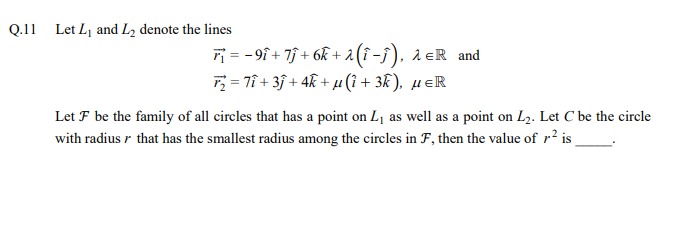Question
Question: Let $L_1$ and $L_2$ denote the lines $\vec{r_1} = -9\hat{i}+7\hat{j}+6\hat{k}+\lambda(\hat{i}-\hat{j...
Let L1 and L2 denote the lines r1=−9i^+7j^+6k^+λ(i^−j^),λ∈R and r2=7i^+3j^+4k^+μ(i^+3k^),μ∈R
Let F be the family of all circles that has a point on L1 as well as a point on L2. Let C be the circle with radius r that has the smallest radius among the circles in F, then the value of r2 is _______.

19
Solution
Let L1 be the line r1=a1+λb1 and L2 be the line r2=a2+μb2. From the given equations: a1=−9i^+7j^+6k^ and b1=i^−j^. a2=7i^+3j^+4k^ and b2=i^+3k^.
Let C be a circle in the family F. By definition, C must contain at least one point from L1 and at least one point from L2. Let P∈C∩L1 and Q∈C∩L2. The distance between any two points on a circle is less than or equal to its diameter. If r is the radius of C, its diameter is 2r. Thus, ∣PQ∣≤2r. Since P∈L1 and Q∈L2, the distance ∣PQ∣ is greater than or equal to the shortest distance between the lines L1 and L2. Let dmin be the shortest distance between L1 and L2. So, dmin≤∣PQ∣. Combining the inequalities, we have dmin≤∣PQ∣≤2r, which implies dmin≤2r, or r≥dmin/2. This shows that the radius of any circle in F must be at least dmin/2. The smallest possible radius for a circle in F is dmin/2.
To confirm that a circle with this radius exists in F, let P0 be the point on L1 and Q0 be the point on L2 such that ∣P0Q0∣=dmin. Consider the circle with P0Q0 as its diameter. The center of this circle is the midpoint of P0Q0, and its radius is ∣P0Q0∣/2=dmin/2. This circle passes through P0∈L1 and Q0∈L2, so it belongs to the family F. Its radius is dmin/2. Thus, the circle with the smallest radius in F has radius r=dmin/2.
We need to calculate dmin, the shortest distance between the skew lines L1 and L2. The formula for the shortest distance is dmin=∣∣b1×b2∣∣∣(a2−a1)⋅(b1×b2)∣.
First, calculate a2−a1: a2−a1=(7i^+3j^+4k^)−(−9i^+7j^+6k^)=(7−(−9))i^+(3−7)j^+(4−6)k^=16i^−4j^−2k^.
Next, calculate b1×b2: b1×b2=(i^−j^)×(i^+3k^)=i^11j^−10k^03=i^((−1)(3)−(0)(0))−j^((1)(3)−(0)(1))+k^((1)(0)−(−1)(1)) =−3i^−3j^+k^.
Now, calculate the dot product (a2−a1)⋅(b1×b2): (a2−a1)⋅(b1×b2)=(16i^−4j^−2k^)⋅(−3i^−3j^+k^)=(16)(−3)+(−4)(−3)+(−2)(1)=−48+12−2=−38.
Calculate the magnitude of b1×b2: ∣∣b1×b2∣∣=∣∣−3i^−3j^+k^∣∣=(−3)2+(−3)2+(1)2=9+9+1=19.
Now, calculate the shortest distance dmin: dmin=19∣−38∣=1938=192×19=219.
The radius of the smallest circle is r=dmin/2: r=2219=19.
The question asks for the value of r2. r2=(19)2=19.
The final answer is 19.
Explanation of the solution:
The smallest circle having a point on line L1 and a point on line L2 must have its diameter equal to the shortest distance between the two lines. This is because for any circle in the family, there exist points P∈C∩L1 and Q∈C∩L2. The distance ∣PQ∣ is less than or equal to the diameter of the circle, 2r. Since P∈L1 and Q∈L2, ∣PQ∣ is always greater than or equal to the shortest distance between the lines, dmin. Thus, dmin≤∣PQ∣≤2r, which implies r≥dmin/2. The minimum radius is dmin/2. We calculate the shortest distance dmin between the skew lines L1 and L2 using the formula dmin=∣∣b1×b2∣∣∣(a2−a1)⋅(b1×b2)∣. We find a1=−9i^+7j^+6k^, b1=i^−j^, a2=7i^+3j^+4k^, b2=i^+3k^. a2−a1=16i^−4j^−2k^. b1×b2=−3i^−3j^+k^. (a2−a1)⋅(b1×b2)=(16)(−3)+(−4)(−3)+(−2)(1)=−48+12−2=−38. ∣∣b1×b2∣∣=(−3)2+(−3)2+12=9+9+1=19. dmin=19∣−38∣=1938=219. The radius of the smallest circle is r=dmin/2=2219=19. The value of r2 is (19)2=19.
